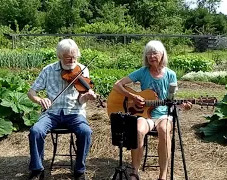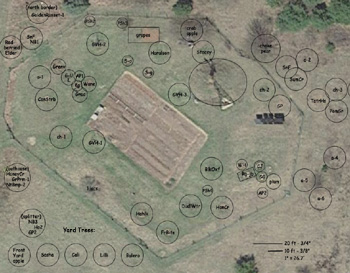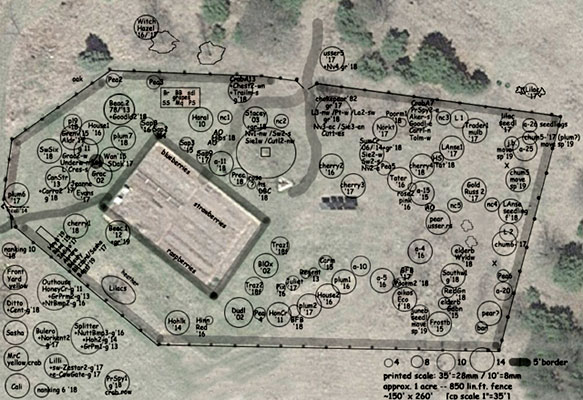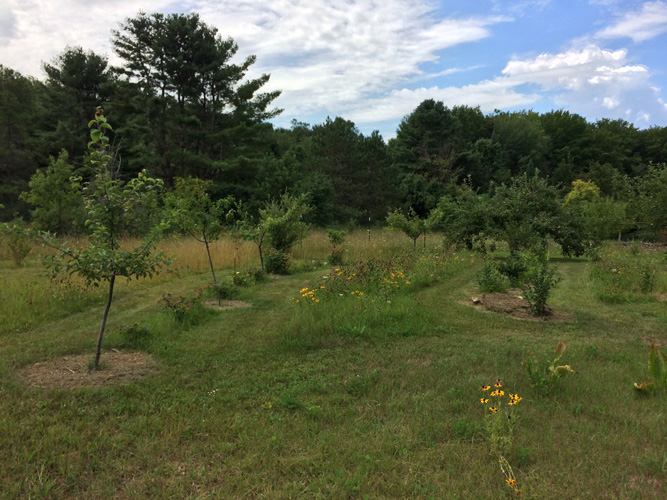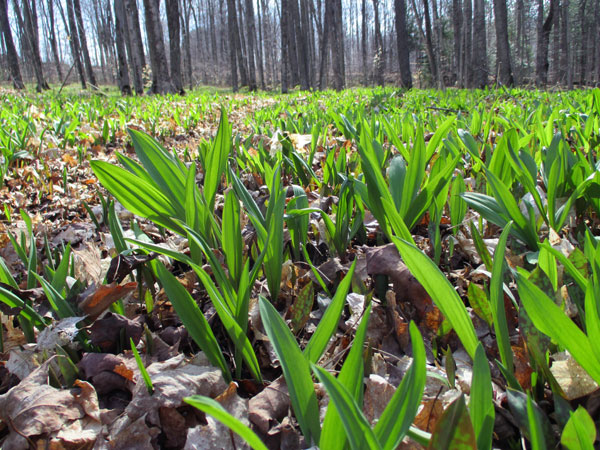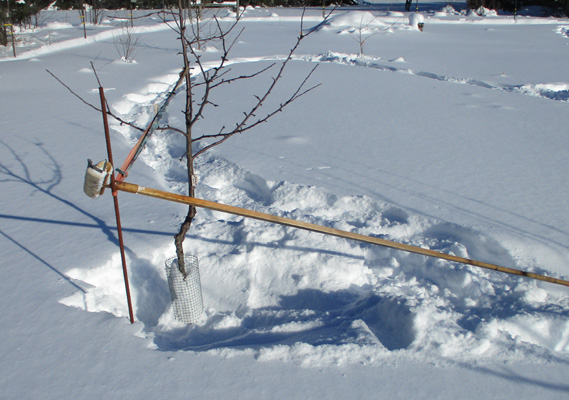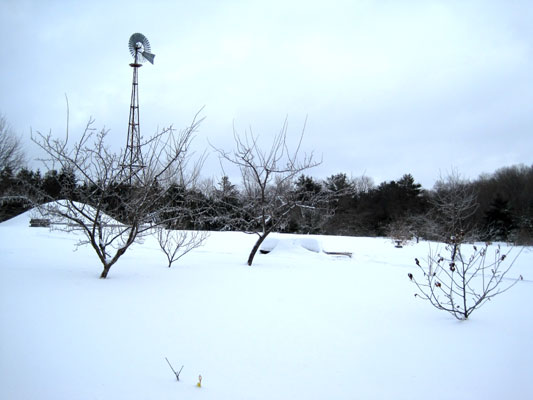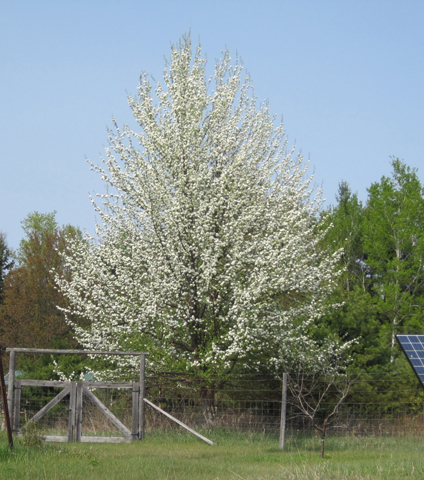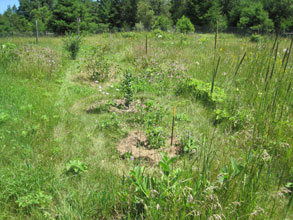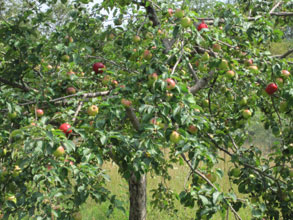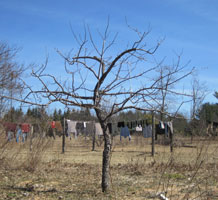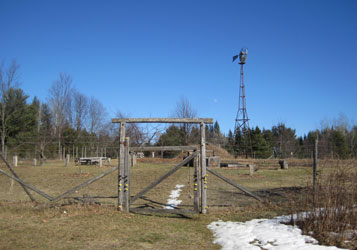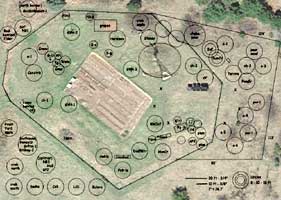|
| ||
|
Apples
Blueberries |
The ManyTracks Orchard with Sue Robishaw
Organic - Healthy - Happy - Fun |
"Growing Berries
|
|
Four decades of Growing
Good Food
in Michigan's Upper Peninsula |
||
|
Almost the first thing we did when we got our future homestead property was to put up a fence for the garden and orchard, before we had even moved there. The next summer we tilled up an area for the garden and planted some fruit trees in the farmed out sandy-loam soil. 1978, more than forty years ago, and we are still putting up fence and planting trees! But now we are enjoying the fruit as well as the labor. It's been, and continues to be, a great adventure, a great amount of learning, and a whole lot of fun. My notes are a little sketchy from those first years; we were busy with working out, building the cabin and house, creating our homestead. We planted those first trees with love but little knowledge. Thankfully some of the trees had strong inclinations to not only survive but grow and produce, and they did, eventually, more in spite of us than because of. The only record I have of that first momentous occasion of the "First Fruit" was a note in my canning notebook, 1987, "70 apples, mostly spys but some macs, good." I assume we were more excited and appreciative than that sounds! Only a few of those original trees are still with us (the "spys" that we were told were Prairie Spys but turned out not to be, and the rootstock pear) but they have been, and continue to be, joined by many more now. The orchard has become my great passion, with Steve's support, help and encouragement. The additions were sporadic and occasional through the years until 2012 when we discovered grafting, and had more time to spend in the orchard. In the summer of 2016 we had 36 trees, and many rootstocks waiting for grafts, plus a nice contingent of small fruits, happily surrounding the vegetable garden. [In 2022 I counted 90 trees!] Many of the trees are not bearing yet but the anticipation is there. The photo above is how the orchard looked in the fall of 2016; map below is two years later, with the much appreciated new fencing in place and many new plantings added. In 2022 it has filled even more with not much more room for additions. But there is still some grafting to do, moves to make, plants to fit in. It continues to be a very enjoyable and creative adventure for me. 2024 - Another dry year, though with different patterns than last year. Little snow in winter - we had bare ground in February and I started pruning the first of March, in record warmth. Finally April was rather more "normal" with seasonal temps and rain. Then nature, as it seems to be usual now, outdid itself with rain in May and June - 12 inches total!! Maybe we had complained a little too much about the dry. But we really appreciated the refresh of the water table, and the land. I didn't hear any complaints about the moisture, from people or trees. Temperatures were moderate all season which was also appreciated, not going much above low-mid 80's mid summer. We finally were used to the warmer normal, as apparently were the trees. There was plenty of hay and mulch for the garden. The mid-August it stopped raining - and it didn't start again until the very end of October. This time I didn't panic, what would survive would and what wouldn't, wouldn't. They all did, and so did we. I watered the smallest, figured the larger could manage themselves which they did. The overall harvests, both garden and orchard, were smaller than usual but certainly respectable. And considering the bumper crops last year it was to be expected, and healthy. We got a rather usual amount of rain in the fall so were able to go in to winter nicely hydrated. Many trees-leaves showed some stress during the drought but overall handled it well. I learn a lot from my trees and plants! Early winter was fairly dry, much like last winter (and continued that way through the winter season). As work/play had continued all through the orchard all through the growing season. I decided to top the fruit trees at ten feet, having the bottom most branch about face high, for ease of movement and mowing. So I brought many of the larger trees down a bit more during spring pruning. Some are managed for an open center with four or five spreading main limbs, others more "christmas tree" shape with more branches more or less evenly spaced around a main trunk. Of course, each of my trees appear quite intent on maintaining their right to their own individuality, so I simply prune, shape, and manage as best I can for good air circulation and reasonable appearance. We get along well. With the early moisture and growth of ground cover I let much of the orchard (save for paths and around the garden) grow and cut for hay. In the later fall I mowed most of the area to help keep the vole population down. Though I'm not sure it really makes a difference. But it does keep bushy and sapling growth in check, especially in the newer east half which would love to grow back into a forest. I have noticed the wild blackberries are easing off now. Since my tool for mowing is an electric hand mower I try to keep growth to a manageable height. When I decided to let an area grow for hay, or I just don't get it mowed in time, then Steve mows with the hand brush cutter or our old walk-behind sickle bar mower (where there's enough space to maneuver). Being in the midst of not-managed field and forest I don't worry about leaving enough native stuff growing for the insects and larger critters. We, thankfully, seem to have a healthy ecosystem for all, with the natural ups and downs of population. And this year one of the "ups" was rabbits and hares (we have both). And I discovered baby rabbits can indeed get through "rabbit-proof" 2"x4" fence we had put up when we expanded the orchard. So we did a quick retrofit adding two foot poultry netting to that half of the fencing. We also had, for the first time in years, raccoons - or, as far as I could tell based on eating habits in the garden, at least one young raccoon. So many hours were spent getting the electric fence back online, and getting used to that routine of checking to make sure it was hot, and managing any shorts. All in the usual life of fitting ourselves into the "wild" life that we live among. 2023 - What a year, and though I know the warming seasons are now common it is still taking some getting used to. The entire year was full of record this, record that, seldom historically normal or average. I started pruning early March with just a foot of snow and mild temps. April started with temps near 50, and by mid-April it was more than warm well into the 70s and most of the pruning done. We celebrated by putting up 6 new Steve-built birdhouses. It would turn out to be a very hard year for all the birds with very few birds and even fewer insects. Not counting mosquitoes which were abundant, but you can't raise many bird babies on mosquitoes. That was what I remember most of this year - hot and dry and quiet - 1/4" rain in May, less than 3/4" in June, temps into the 80's. I watered - bucket upon bucket upon bucket - morning and evening - almost every day, hoping our well would stay wet (it did!). I couldn't do anything for the older large bearing trees but I hoped to get enough moisture to the younger trees and bushes (and the garden) to keep things alive. I didn't figure we'd have much of a crop. Tree leaves were often curling due to the drought. Finally it rained in July (3 1/2" - hurray!!) and temps were more normal. August and September managed to come up with about 2" each, low but so appreciated. The earth made use of every drop. So we had the unusual experience of dry, brown vegetation in the spring, finally greening up in late summer! And the harvest? The apples outdid themselves! Just about every tree that could put out fruit in abundance. I had to remove blossoms from trees too young to bear more than one or two apples, and I thinned and thinned the older trees. Was it because they were stressed or because they loved the warmer weather? I don't know. It will be interesting to see what they do next year. There were very few pears due to the usual late spring freezes (yes, in spite of the unusual heat!) at the "wrong" time during bloom. But for the first time in decades we had plums! There was fireblight and tip-blight in some of the apples, but kept in check by pruning off when noticed and all did fine. Overall the orchard did well, fed us very well. The trees reminded me that they know how to handle the ups and downs of the weather, trust them to do what they do, and quit worrying about it. I appreciated every one. 2022 - A good year in the orchard, with the now usual weather extremes, though ours aren't as extreme as in many parts of the County. A cool beginning, hot middle, and about average fall. Enough moisture. Every year brings new surprises. There was more scab in the apple trees but not overwhelming, a few new insects, happy birds, no fireblight (yah!), some blossom blight but seemed manageable, many berries, and plenty of apples for fresh eating, drying, sauce and cider. It was the first year with a significant Aronia crop, which added color and nutrition to the applesauce, and first apples and pear, which is always fun. Had to remove all the planted gooseberries due to signs of White Pine Blister Rust (sad) but added some new hazelnuts (fun). The orchard (and surrounding woods and fields) is such an ever changing and interesting world. The growing season seems to go by fast, and then I start dreaming and planning for next year.
It's never a cut and dry pattern as I also prefer to discourage voles and anything that wants to send seed into the garden area. The older half has vegetation that grows thick and lush while the newer half is mostly thin and working on building up its soil. So some sections get mowed often, others seldom, and it all depends on what I'm thinking or feeling when I get out there with the mower! But thankfully the trees seem to do just fine no matter what I do so it's a happy world in the orchard. 2021 - A very mild and light snow winter, not much more than a foot. The first "big" snowfall didn't happen until Feb.12. Winter continued into an early, warm spring. Except for a few small, and short lived, snowfalls the orchard was bare before the end of March. Most came through winter fine, except Norkent. Pruned through April. It continued unusually warm and dry into later June with no rain. Watered small trees. Trees bloomed early. Everything grew early. Grafted May 17, 20 total, 70° day. Hit with four freeze nights end of May, 22°-28° while apples and pear in full bloom, plums & cherries finishing. Looks like it will be a "rest" year for fruit. Record heat all summer with minimal rain, but enough after June 18. Very good growth. Most everything did fine except for fireblight continued in Stacey pear and Chokepear. Very mild fall; no frost until Oct. 18. Then more usual weather so all appeared to go dormant in good time. Ended up with light harvest of apples, especially Black Oxford which was a nice surprise. Mowed orchard floor mid summer then late fall to help discourage voles.
A brisk but beautiful day today allowed me to finish pruning the large apple trees inside the orchard/garden fence. It's been a lot of reshaping these past years but they are now all looking good so the pruning isn't as difficult which is nice. They still love to grow branches where I don't want them to be so it's an every year event but enjoyable. I admit, I like getting up close and personal with my trees! While I was making (relatively) smaller cuts with hand pruners, loppers and pruning saw Steve was making big cuts taking out some vigorous white pines near the path to the hangar and cutting back blackberry canes so we can walk by without getting snagged. They do love to grow which is fine, but we like to have some space, too.
And it is a very growing time of year, everything moving and so amazing. The leeks in the woods haven't minded at all the colder weather as they spread their so cheery carpet of green. They go well with the fresh green of the fir trees interspersed in the hardwoods. So many things are coming along - the first Spring Beauties flowering, the Trout Lillies coming up under the protection of the leeks and growing grass, rhubarb making headway in the garden. The sky is active, too, and not just with clouds. The Cranes are on the move and we had a large flock, maybe 75-100, stop over the night west of here, maybe visiting the locals who have been around for several weeks now. This morning as the day warmed and the thermals began the group took to the sky, vigorously calling to each other, group after group finding a thermal to circle higher, joining others, higher and higher, moving north. I stop and watch until I can't see them any more. Underneath the Cranes, much closer to the ground, soar several large Vultures and as they moved off south one stayed behind off to the north and I realized it was an immature Bald Eagle. The hawks are on the move, too. As I was up on the ladder pruning a shadow went over and I looked up to see a beautiful large white (male) Marsh Hawk* swoop over my head, low over the garden, up and over large apple trees then off east over the woods. You can be sure it was very quiet in the orchard as everyone kept very still. I went back to work, then the Phoebe started with its two note song, the Chickadee pair headed back to check out what they could glean from the compost pile, and the Bluebird flew back up onto the tail of the windmill, hanging on tight as it turned in the wind. It was a great day to be outside on the homestead. * Since I didn't remember which Marsh Hawk, male or female, was white (the other is brown) I looked it up, only to find that they changed the name -- our impressive Marsh Hawks are more properly to be called Northern Harriers. Since they did this almost 40 years ago and we've been calling them Marsh Hawks all this time with no problems I guess it won't be of any concern if we continue to call them Marsh Hawks for another 30 or 40 years. They are a beautiful bird/hawk, easily identified with that bright white patch on their rump, and one we enjoy even more now when we don't have chickens. February 20 -- Orchard Chores
2020 - What a year... Cold cloudy fall, mild winter ('19-'20), plenty of snow starting early December with a very heavy storm, then another, the 2-3 feet of snow lasting to the end of March. Grafts and trees made it through winter OK except for some broken limbs/branches from the heavy wet snow, especially low ones. Crazy record cold 1st half May - directly to record HOT 2nd half right through till the end of August (with some freezes here and there in June). Often in the 80's. This is not our usual summer weather! We had a mild fall, a lot of sun, and a late winter onset (no real snow until Feb. 12, 2021!). I cut scions Feb. 20, did some pruning Feb. 24, then the rest starting April 10, with the snow mostly gone. Pruned off all low branches on small trees and bushes (to avoid snow breakage in the future). Grafted May 20 (when it finally warmed up), 70 total, our biggest year yet. The county road crew had chipped stuff along our road into convenient (for us) piles. We picked up 2 truckloads, making the neighbors happy to have them out of their yards and me happy to have them. I spread around many trees. It was OK but it still got grassy and was hard to mow. Probably won't do that again. I added metal tags to last year's grafts. Except for pears the orchard did well overall. I had the first 'whole tree' graft to bear fruit - Norkent - 20 apples and they were delicious. Mowed the entire orchard late summer/early fall to discourage voles. Our focus on work on house this year left the orchard pretty much to itself. It did fine. The only bummer was massive fireblight in Chokepear and Stacey, and some in usser5. Young pears and Summercrisp not touched. Just a few strikes in apples. Had never had anything like that before, but we'd never had weather like this before. I hope it was a once-in-a-lifetime event.
The North Orchard grew as well, gaining new trees, developing its patterns. Not too much to be added now; just letting them all grow, each as they will. The area exploded in growth with the new-found sunlight and air, and growing on the good soil and needle/leaf mulch left by the removed trees. The young trees are well protected by the vigorous vegetation, securing their own spots in the mix with the help of generous mulch. It's a community in the making, and so interesting to watch. 2018 - There was not much "usual" about this season's weather. December jarred the orchard with sudden large temperature drops, close to record lack of snow and a record population of voles didn't help, then record cold in April into a very sudden jump to summer temps in May - the start of an unusually long, hot summer. It's a wonder that anything survived, but most of them did. Between the weather and the voles the orchard sustained more damage and loss than usual (which is usually minimal) but we all kept on trucking, and overall it was a decent year. More rolls of hardware cloth were purchased to make sure everything was protected before winter, and I marveled at the regrowth during the season of those that lost bark to the hungry voles. It was a busy, active year in the main orchard starting with more than 40 grafts the end of May and planting many new bushes and trees spring and fall. It's exciting to see the orchard grow in its many different ways.
So, what to do but find a spot where I could plant free ranging trees, and there happened to be an area just right for that on the north edge of our property. There was a once open bay in the woods, now quite grown in with white pine and wild black cherries that would be great for this new orchard area. About a half acre, it was well protected north, northwest and east by woods; fronting on open field to the south and southwest. Perfect. Well, once the many large white pines and cherries were removed! Early spring Steve went to work, and work it was, making large brush pile "hedges" along the woods to the delight of birds and critters, making an opening for the new North Orchard. And I started transplanting trees and bushes, having spent the winter planning. This is a many year project but the idea is to plant (mostly) fruit tree seedlings of many types, on their own roots (not grafted) that can grow to their full potential, for the wildlife and our enjoyment and interest. It's a satisfying addition to my orchard passion. A Growing Organic Orchard - September 27, 2017
Decoy Apples - August 21, 2017
Summer came and I painted any of those of my plastic fruit, or round apple
like objects, that weren’t already red and attached wire hangers. When my
real apples started ripening I hung plenty of red decoys in the trees (all
thse “red apples” in the photo). I really didn’t want to share my good
apples with the birds. They have plenty of crab apples to eat.
Spring Pruning - April 14, 2017 We have four
producing “tame” apples and one pear. These are all trees we planted. There
are also a half dozen wild apples with varied fruit quality but I usually
make use of the apples in sauce or cider. Some of the trees I’ve been
working on for many years to get them to a manageable size and they are all
now finally coming into shape, each in their own way. But all can now be
reached standing on the top of my 8 ft ladder for pruning and harvesting.
Though not as impressive as the 30 ft standard trees we used to have they
are much easier to care for and give us better fruit. I’m happy with the new
11-12 foot heights, and I hope the trees are, too. Odd Year in the Orchard - March 7, 2017
ORCHARD - Expanded - December 16, 2016
A couple of fruit trees had already settled beyond the
current fenced half acre of land where about 30 fruit trees plus various
shrubs, berries and large garden are nicely protected from deer and
raccoons. But there just wasn’t room for all the plantings of my dreams to
fit in there. We have already grafted onto a number of wild crab/apple
seedlings out and about but they will require individual fences for many
years to come to keep the deer from “pruning” them to stubs. Then they’ll
need to be grown tall enough to keep at least some of the fruit out of their
reach if I want to harvest any for us. That’s fine for a handful of trees
but not for the number I’m planning. Plus I want to grow my trees shorter
than “above deer reach”. It was obvious -- the fenced in orchard needs to
expand. Happily, just east of our current set-up makes sense. We roughly
outlined where the new fence could go, given the terrain and the existing
white pines, wild black cherries and other wild growth. The fairly open area
was full of dewberry brambles and rough field so we mowed it with sickle bar
and hardy, overworked gas “lawn” mower, and Steve cut down a few trees. I
spent many a happy hour with PhotoShop moving little circles around and
imagining what might go where. Then back and forth to the “real” plot to
re-organize and re-arrange based on what felt and looked right in person. I
wanted groups of fruit trees with room for lower growing shrubs and plants.
Copyright © Susan Robishaw |
||


